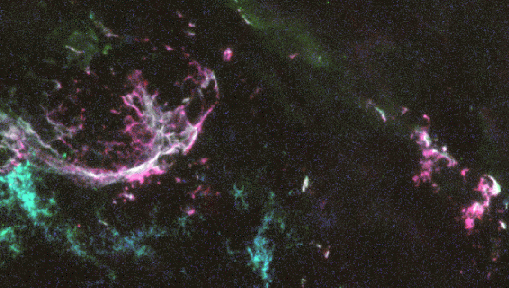Explanation: Massive stars cook elements in their cores through nuclear fusion. Starting with the light elements of hydrogen and helium, their central temperatures and pressures produce progressively heavier elements, carbon, oxygen, nitrogen, etc. up through iron. At the end of their lives they explode in a spectacular supernova, scattering these elements into space, contributing material to the formation of other stars and star systems. In fact, the elements making up life on Earth were baked in such a stellar oven! This Hubble Space Telescope image of a supernova remnant known as N132D in the Large Magellanic Cloud (LMC) allows astronomers to explore the details of this nuclear processing and mixing. It reveals luminous clouds of cooked supernova debris energized by shocks -- singly ionized sulfur appears red, doubly ionized oxygen, green, and singly ionized oxygen, blue. The region shown above is about 50 lightyears across.
1999 2000 2001 2002 2003 2004 2005 2006 2007 2008 2009 2010 2011 2012 2013 2014 2015 2016 2017 2018 2019 2020 2021 2022 2023 2024 2025 |
Январь Февраль Март Апрель Май Июнь Июль Август Сентябрь Октябрь Ноябрь Декабрь |
NASA Web Site Statements, Warnings, and Disclaimers
NASA Official: Jay Norris. Specific rights apply.
A service of: LHEA at NASA / GSFC
& Michigan Tech. U.
|
Публикации с ключевыми словами:
LMC - supernova remnant - supernova - Эволюция звезд - остаток Сверхновой - Сверхновые - термоядерные реакции - Большое Магелланово Облако
Публикации со словами: LMC - supernova remnant - supernova - Эволюция звезд - остаток Сверхновой - Сверхновые - термоядерные реакции - Большое Магелланово Облако | |
См. также:
Все публикации на ту же тему >> | |
